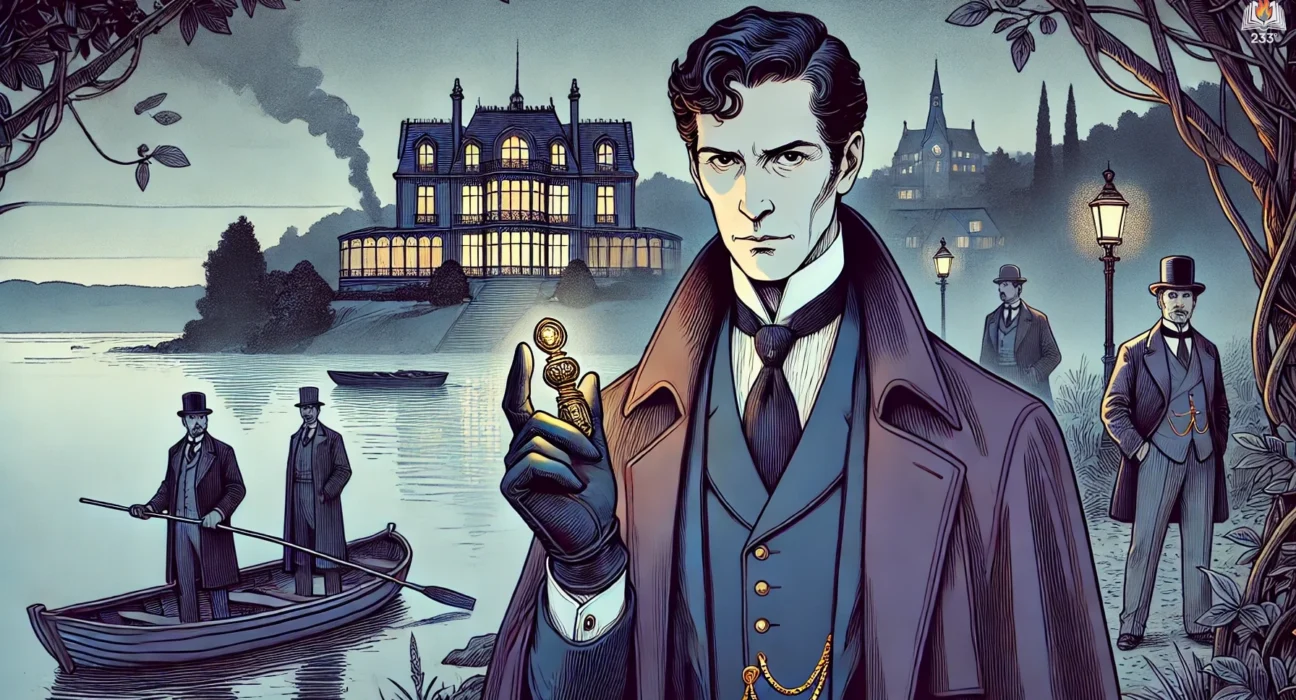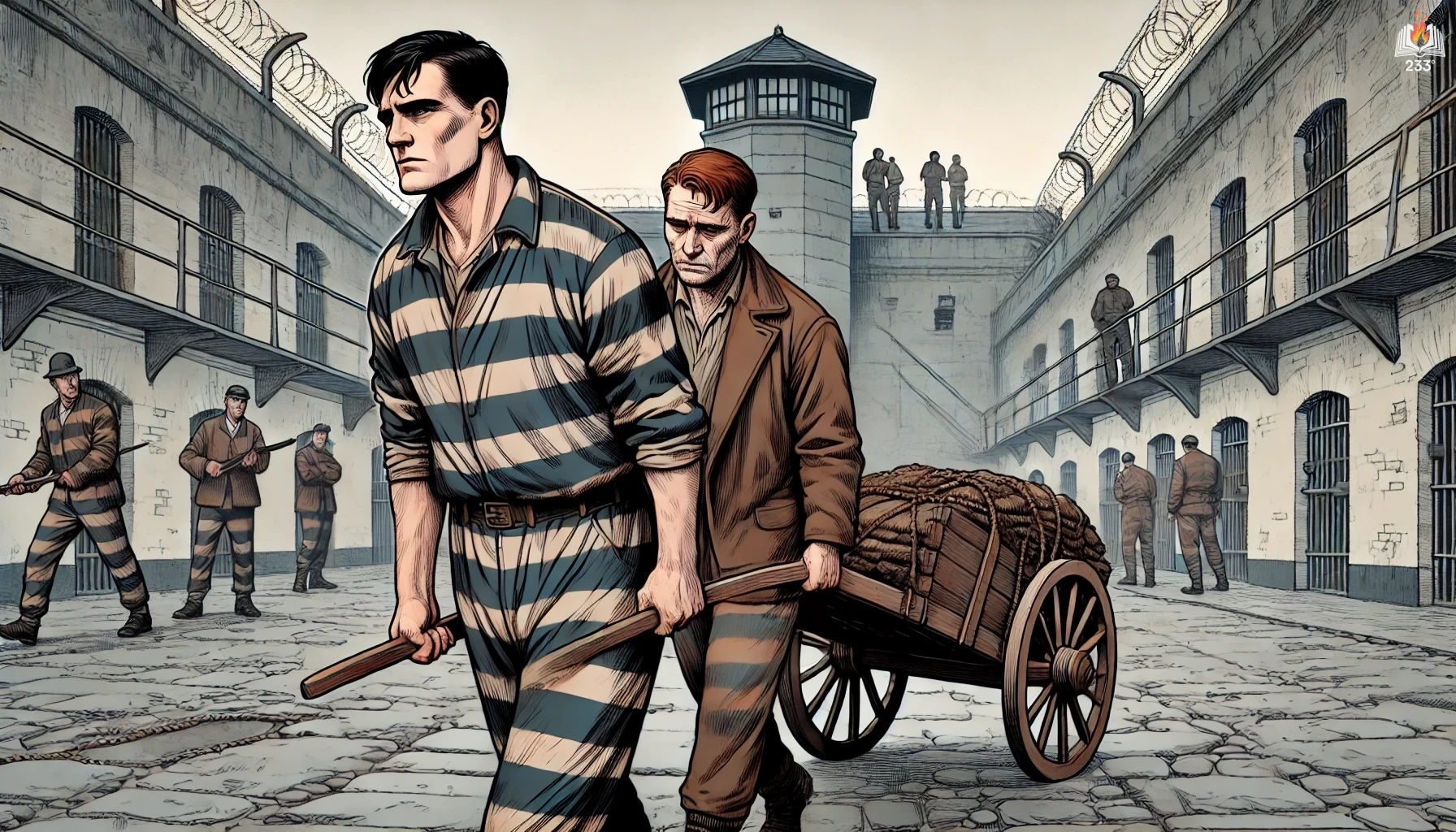The Crystal Stopper, written by Maurice Leblanc and published in 1913, is part of the famed Arsène Lupin series. Known for his charm, wit, and complex character, Lupin is often called France’s answer to Sherlock Holmes. In The Crystal Stopper, Leblanc takes Lupin through a suspenseful journey filled with unexpected twists, treachery, and clever schemes as Lupin races against time to clear his associates, who are wrongfully implicated in a crime. Set in the elegant but shadowy world of early 20th-century France, the novel captures a vibrant Parisian backdrop and an intricate web of conspiracies and intrigue.
Plot Summary
At the edge of Lake Enghien on a foggy September night, Arsène Lupin orchestrated what appeared to be another flawless heist. He, along with his two trusted accomplices, Gilbert and Vaucheray, had set their eyes on the villa of Deputy Daubrecq, a man of significant influence and dark secrets. The heist began smoothly, with the men slipping through the mists on small boats, avoiding the odd couple out for a late-night row or revelers singing on the lake. Inside the villa, they moved with precision, gathering prized items and valuables. Yet Lupin’s instincts tingled with unease, a shadow in his mind warning him of unseen trouble. His worst fears crystallized when Daubrecq’s valet, Leonard, burst out, shouting for help. A struggle erupted, and amid the chaos, Leonard lay dead. In the turmoil, Lupin’s quick mind seized the chance to make his escape. Gilbert and Vaucheray, however, were less fortunate.
Gilbert and Vaucheray were promptly arrested, charged with murder. Evidence mounted swiftly against them: the bloodshed, Leonard’s last desperate phone call for help, and a chilling artifact left behind by Lupin himself — his infamous calling card. Although Daubrecq had been absent from his home during the crime, his role soon became clear. The crystal stopper that Lupin had unwittingly taken was no ordinary piece. Lupin’s astonishment was profound as he discovered Gilbert and Vaucheray had known of the stopper’s presence and its inexplicable importance all along. This had not been a simple heist but an intricate ploy to obtain this seemingly insignificant object, a small crystal stopper with a gilded knob.
Back in his Parisian flat, Lupin had taken possession of the crystal stopper only to have it vanish under mysterious circumstances that night. Thorough as ever, he locked his door and bolted the room; yet, by morning, the stopper had disappeared without a trace, as though a phantom had stolen into his private sanctuary. With Gilbert and Vaucheray’s fates hanging in the balance, Lupin was determined to uncover the truth about Daubrecq and the stopper. His next steps would lead him down a perilous path where political influence and personal vendettas converged in dangerous ways.
As Lupin probed further, he learned of Daubrecq’s reputation as a corrupt, wealthy politician whose moral compass bent to suit his ambitions. Daubrecq was a man who valued power above all, using it to manipulate, blackmail, and control. Lupin’s efforts to uncover the mystery of the stopper brought him face-to-face with Daubrecq’s nemesis, the ambitious Prasville, a former lawyer now appointed as Secretary-General at the police department. Prasville, known for his aggressive pursuit of justice, had been watching Daubrecq closely, convinced that the deputy held a dangerous secret.
Observing Daubrecq’s home under disguise, Lupin witnessed a bizarre ritual — the strange note scrawled by Daubrecq, “Eight from nine leaves one.” It became clear that Prasville was after something specific: a powerful piece of information or item that Daubrecq possessed, and Lupin suspected the stopper held the key. Yet Daubrecq, with all his tricks and secured lairs, evaded every attempt to pry out his secret.
To Lupin’s advantage, a loyal friend, Victoire, entered the fray. Disguised as Daubrecq’s cook, Victoire began a risky infiltration. Under Lupin’s direction, she searched the house thoroughly, but their progress was slow. Daubrecq, ever observant, began to suspect Lupin’s involvement, treating Victoire’s presence with a mixture of wariness and wry amusement. With time slipping away, Lupin became increasingly desperate to rescue Gilbert and Vaucheray, who awaited trial with grim certainty. Even as they searched, Gilbert managed to smuggle a letter to Lupin, which a mysterious woman intercepted, leaving Lupin enraged and unsure of how close his enemies had come to his plans.
Lupin’s attempts to trap Daubrecq seemed to reach dead ends at every turn, until a bold plan took shape in his mind. He would confront Daubrecq directly. If Daubrecq were forced to bargain with him face-to-face, Lupin might gain the upper hand. Donning another clever disguise, Lupin finally arranged a meeting with Daubrecq. But Daubrecq, equally shrewd and anticipating Lupin’s trickery, met him with cold cunning. A master of deception himself, Daubrecq humored Lupin, confident that the stopper’s power and his own political influence protected him. He taunted Lupin with his plans, hinting at the destructive potential of the stopper.
Frustrated but not defeated, Lupin resolved to pull every string within his vast network. He gathered information from all quarters, until at last, a shred of the truth emerged. The stopper held a list that could destroy Daubrecq and dozens of others. It was a key to blackmail, his grip over powerful figures across Paris. Daubrecq’s survival — even his rise to political power — rested on his ability to keep that list secure. This revelation spurred Lupin into a frenzy, leading to a final, perilous attempt to retrieve the stopper.
On the eve of the scheduled execution, Lupin launched an intricate plan, determined to save his friends at any cost. Breaking into Daubrecq’s villa in a final confrontation, he uncovered the location of the stopper. Yet Daubrecq’s defenses were airtight, and the deputy had placed guards in every corner of his estate. Every moment counted as Lupin fought his way through, evading capture at every turn. With clever maneuvering, Lupin retrieved the crystal stopper, barely escaping with his life.
Rushing to the prison, Lupin arrived only hours before Gilbert and Vaucheray were to face their fates. The stopper, bearing evidence that implicated Daubrecq and exonerated his friends, was the last remaining chance. Presenting it to the authorities with unassailable evidence of Daubrecq’s corruption, Lupin turned the tide of justice. Gilbert and Vaucheray were freed, and Daubrecq’s vast web of blackmail unraveled, his power diminished and his reputation forever stained.
The crystal stopper, so deceptively small and simple, had nearly cost Lupin his closest allies and his own freedom. Yet he had prevailed through ingenuity, loyalty, and an unbreakable will to see justice done. Though the path had been fraught with danger and loss, Lupin walked away victorious, a cunning smile hinting at the satisfaction of yet another impossible feat accomplished.
Main Characters
Arsène Lupin – A sophisticated, daring gentleman thief whose intellect and charm are matched by his sense of justice. Lupin, as ever, is cool-headed, witty, and resourceful, navigating complex situations with a mixture of clever manipulation and genuine concern for his allies.
Gilbert – A young accomplice of Lupin’s who becomes entangled in the criminal plot surrounding the crystal stopper. Loyal to Lupin, Gilbert’s dedication to his mentor is overshadowed by the danger he faces, which forces Lupin into a race against time to prove his innocence.
Vaucheray – Another of Lupin’s close associates, Vaucheray is both loyal and flawed, contributing to the layered morality within Lupin’s gang. His involvement in the criminal situation complicates Lupin’s plans, highlighting the dangers of loyalty to a life of crime.
Daubrecq – A sinister figure and a powerful adversary, Daubrecq is a manipulative deputy who holds dangerous secrets and wields his political influence ruthlessly. He is portrayed as one of Lupin’s more cunning and morally dubious enemies, driving much of the novel’s tension.
Theme
Justice and Loyalty – The novel explores the boundaries of loyalty, particularly through Lupin’s efforts to save Gilbert and Vaucheray from wrongful punishment. This loyalty often blurs the lines between legality and morality, questioning whether the pursuit of justice justifies breaking the law.
Deception and Identity – Leblanc deftly uses themes of deception, with characters constantly disguising their intentions and identities. Lupin’s own persona embodies this, and he repeatedly shifts between roles to achieve his ends, emphasizing the theme of fluid identity in a morally ambiguous world.
Power and Corruption – Through Daubrecq’s character, Leblanc critiques the misuse of political power. Daubrecq’s willingness to exploit his position for personal gain contrasts with Lupin’s sense of justice, casting a critical eye on those who use authority corruptly.
The Nature of Crime – Lupin’s character often operates in the gray areas of legality. The novel frequently questions what constitutes a true crime, as Lupin’s ethical motives contrast sharply with the ruthlessness of Daubrecq and others.
Writing Style and Tone
Leblanc’s writing is known for its quick pace, witty dialogue, and intricate plot twists, all of which contribute to a sense of excitement and intellectual engagement. His prose is descriptive, immersing readers in the Parisian world of Lupin, with elaborate scene settings that contrast sharply with the stark, suspense-driven dialogues. Leblanc’s language is eloquent yet accessible, infusing moments of humor and irony that underscore Lupin’s larger-than-life personality.
The tone of The Crystal Stopper oscillates between suspenseful and light-hearted, a duality that mirrors Lupin’s own personality. While the stakes are high, Leblanc maintains a playful edge, allowing readers to enjoy Lupin’s escapades even as the plot ventures into dark and morally complex territory. This balance of light and dark, humor and danger, is a hallmark of Leblanc’s writing, adding depth to both the narrative and its themes.
We hope this summary has sparked your interest and would appreciate you following Celsius 233 on social media:
There’s a treasure trove of other fascinating book summaries waiting for you. Check out our collection of stories that inspire, thrill, and provoke thought, just like this one by checking out the Book Shelf or the Library
Remember, while our summaries capture the essence, they can never replace the full experience of reading the book. If this summary intrigued you, consider diving into the complete story – buy the book and immerse yourself in the author’s original work.
If you want to request a book summary, click here.
When Saurabh is not working/watching football/reading books/traveling, you can reach him via Twitter/X, LinkedIn, or Threads
Restart reading!








